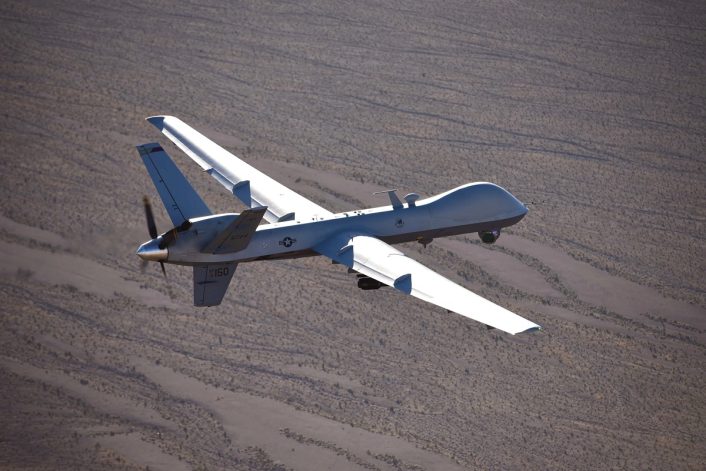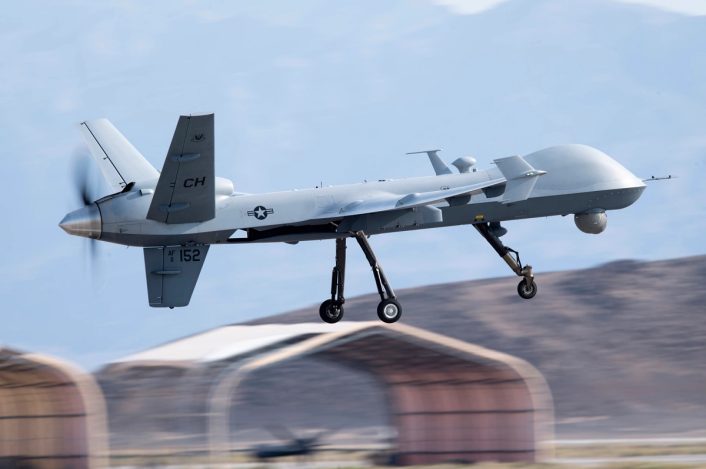The MQ-9s of USSOCOM and AFSOC will get cyber anomaly detection and predictive maintenance capabilities, as well as a podded Airborne Battlespace Awareness and Defense capability.
General Atomics Aeronautical Systems announced that the MQ-9A Reaper will receive new upgrades to make it more survivable against today’s ever-evolving threats. The upgrades are meant to keep pace with the needs of U.S. and allied special operations forces and will equip the remotely piloted aircraft of the United States Special Operations Command and Air Force Special Operations Command.
This news reflects the increased focus on cyber security, with all services working to improve the cyber protection of their systems and deny access to adversaries who could potentially try to remotely violate and degrade aircraft, vehicles, networks. In the past, the Air Force already took steps to assure the integrity of the Reaper’s cyber networks and protect the support equipment that connect the aircraft to the cockpits on the ground.
Also, the news reflects the need to better protect the MQ-9, after last month another one was shot down by the Houthis, bringing to five (six if we include the one damaged by Russian fighters over Syria) the RPAs lost to hostile fire in just a year. While the aircraft has been invaluable in low-threat scenarios like Afghanistan, it becomes highly vulnerable even against basic anti-air defenses.
The MQ-9 has already demonstrated its adaptability, however these upgrades might allow the RPA to continue to play its role in modern operations without relegating it to the sidelines. With many programs currently in progress, the Reaper will in fact get more capabilities than just basic Intelligence, Surveillance and Reconnaissance and Close Air Support.
Shift5’s Onboard Data Access and Analysis
On May 8, 2024, GA-ASI announced its partnership with Shift5 to integrate the company’s onboard cyber anomaly detection and predictive maintenance capabilities Shift5 is an observability platform for onboard operational technology, created by officers who stood up U.S. Army Cyber Command and pioneered modern weapons system cyber assessments.
“GA-ASI has long maintained a focused commitment to unmanned combat operations and unmatched unmanned aircraft system (UAS) experience, exemplified through our MQ-9A Reaper,” said GA-ASI President David R. Alexander. “The next logical and immediate extension of our work in enabling the U.S. Air Force is empowering AFSOC and SOCOM with additional resiliency and survivability of the MQ-9A on the battlefield. Shift5 represents a new class of dual-use defense tech business that can successfully operate at speed and scale with us to make an immediate impact for the warfighter.”

An MQ-9 Reaper flies a training mission over the Nevada Test and Training Range, July 15, 2019. MQ-9 aircrew provide dominant, persistent attack and reconnaissance for comabtant commanders and coalition partners across the globe. (U.S. Air Force photo by Airman 1st Class William Rio Rosado)
The Shift5 Platform reveals critical operational and cybersecurity insights that enable operators to move from data to decisions quickly and confidently, says the company. The platform can deploy on premises or in the cloud and supports streaming and air-gapped modes for offline and online capability, allowing real-time data access, contextual insights, and actionable analytics.
“The battlefield of the future will include more remotely piloted, autonomous, and unmanned systems. Central to maintaining advantage in this operating environment is access to real-time data,” said Josh Lospinoso, CEO and co-founder of Shift5. “Our work with GA-ASI represents one of the most efficient and effective ways that AFSOC and SOCOM can gain access to critical operational and cybersecurity insights, democratize that data, and maintain decision dominance.”
Shift5 mentions it achieved its first cross-platform Authority to Operate (ATO) Certification from the U.S. Department of Defense in April 2023, validating the resilience and security of the Shift5 Platform. Most recently, the company announced its contract with the U.S. Army to secure the High Mobility Artillery Rocket System (HIMARS) against cyber threats and provide readiness assessments to enable predictive maintenance.
The company also recently introduced the GPS Integrity Module, a cross-platform solution to automate detection and alerts to combat GPS spoofing risks by assessing changes in navigational position through anomaly detection methods, alerting operators to GPS spoofing attacks as they happen.
Global navigation satellite systems (GNSS) are becoming increasingly unreliable because of jamming and spoofing, posing a threat not only to national defense, but also to commercial transportation systems. Just think of the recent news of Russian jamming declining to only 6% the efficiency of Ukrainian GPS-guided munitions and blocking commercial aircraft from landing in Estonia because the GPS RNAV procedures became unusable.
Airborne Battlespace Awareness and Defense pod
On May 9, GA-ASI announced that work is in progress with USSOCOM and AFSOC to develop a new podded Airborne Battlespace Awareness and Defense (ABAD) capability. It is not known if the new capability is somewhat related to Self-Protection Pod (SPP) that the company revealed in 2021.
The new ABAD pod is being developed for the AFSOC fleet of MQ-9A Block 5 Medium-Altitude, Long-Endurance Tactical (MALET) Extended Range RPAs and will provide detection and protection against Radio Frequency (RF) and Infrared (IR) threats. GA-ASI says work is underway on an engineering and test effort to mature the capability as a podded payload capable of operation on the MQ-9A in 2025.

“Threat awareness and survivability are critical for MQ-9A to operate in contested environments,” said GA-ASI President David R. Alexander. “ABAD will enable the tracking of RF and IR missile threats, enable defensive measures, and real-time threat awareness for MQ-9A.”
The company says that an evaluation of suitable RF and IR countermeasures systems led to the down selection of an unspecified next-generation software-defined radio-based Electronic Warfare system from BAE Systems and the AN/AAQ-45 Distributed Aperture Infrared Countermeasure System (DAIRCM) from Leonardo DRS.
“BAE Systems’ advancements in small form factor EW technologies will provide affordable multifunction capabilities for the MQ-9A, enabling it to operate in previously inaccessible airspace,” said Joshua Niedzwiecki, vice president and general manager of Electronic Combat Solutions at BAE Systems, without giving details on the selected system.
DAIRCM was already integrated in the previous Self-Protection Pod, which also included a Raytheon AN/ALR-69A(V) Radar Warning Receiver (RWR), the BAE Systems ALE-47 Countermeasures Dispenser System and the Terma AN/ALQ-213 Electronic Warfare Management System. All these systems are Commercial Off-The-Shelf components which are already proven and employed by U.S. aircraft.
“Leonardo DRS is delighted to team with GA-ASI to provide our industry-leading and proven AN/AAQ-45 DAIRCM aircraft protection system to enhance MQ-9A survivability in support of this mission for USSOCOM,” said DRS Vice President of the DAIRCM Program, David Snodgrass.









